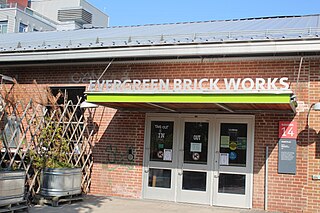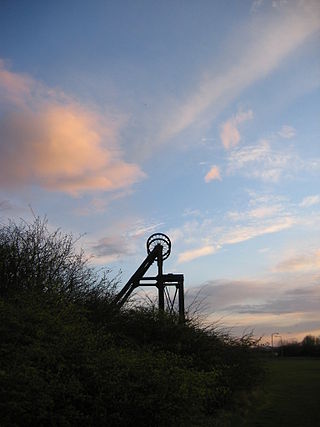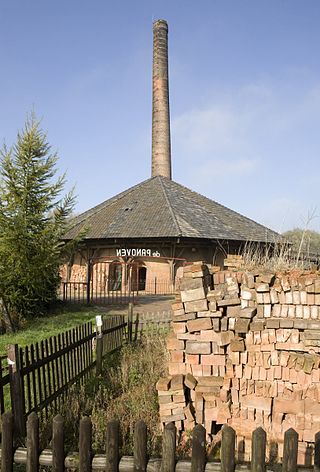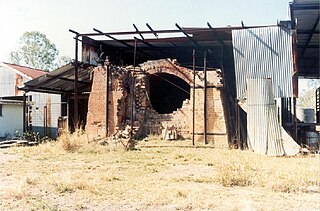
A brick is a type of construction material used to build walls, pavements and other elements in masonry construction. Properly, the term brick denotes a unit primarily composed of clay, but is now also used informally to denote units made of other materials or other chemically cured construction blocks. Bricks can be joined using mortar, adhesives or by interlocking. Bricks are usually produced at brickworks in numerous classes, types, materials, and sizes which vary with region, and are produced in bulk quantities.

Brandenburg an der Havel is a town in Brandenburg, Germany, which served as the capital of the Margraviate of Brandenburg until it was replaced by Berlin in 1417.

The Don Valley Brick Works is a former quarry and industrial site located in the Don River Valley in Toronto, Ontario, Canada. The Don Valley Brick Works operated for nearly 100 years and provided bricks used to construct many well-known Toronto landmarks, such as Casa Loma, Osgoode Hall, Massey Hall, and the Ontario Legislature. Since the closure of the original factory, the quarry has been converted into a city park which includes a series of naturalized ponds, while the buildings have been restored and opened as an environmentally focused community and cultural centre by Evergreen, a national charity dedicated to restoring nature in urban environments.

A brickworks, also known as a brick factory, is a factory for the manufacturing of bricks, from clay or shale. Usually a brickworks is located on a clay bedrock, often with a quarry for clay on site. In earlier times bricks were made at brickfields, which would be returned to agricultural use after the clay layer was exhausted.

St Peters is a suburb in the Inner West of Sydney, in the state of New South Wales, Australia. It is 7 kilometres south of the Sydney central business district, in the local government area of Inner West Council, with a small section in the southeast in the City of Sydney.

Sydney Park is a 41.6-hectare (103-acre) recreational area in the inner-city area of Sydney, New South Wales, Australia. The parkland is located in the suburb of Alexandria, sitting along the borders with Newtown and Erskineville.

Paretz is a village in the German state of Brandenburg in the district of Havelland, west of Berlin. Recently, a district reform made Paretz into a borough of the city of Ketzin. It has a population of approximately 400. In the late 18th and early 19th centuries, the village was the summer residence of King Frederick William III of Prussia and of his wife Queen Louise.

A Feldbahn, or Lorenbahn, is the German term for a narrow-gauge field railway, usually not open to the public, which in its simplest form provides for the transportation of agricultural, forestry and industrial raw materials such as wood, peat, stone, earth and sand. Such goods are often transported in tipper wagons, known in German as Loren, hence such a railway is also referred to as a Lorenbahn.

The Gladstone Pottery Museum is a working museum of a medium-sized coal-fired pottery, typical of those once common in the North Staffordshire area of England from the time of the Industrial Revolution in the 18th century to the mid 20th century. It is a grade II* listed building.

The Hoffmann kiln is a series of batch process kilns. Hoffmann kilns are the most common kiln used in production of bricks and some other ceramic products. Patented by German Friedrich Hoffmann for brickmaking in 1858, it was later used for lime-burning, and was known as the Hoffmann continuous kiln.

Prestongrange Museum is an industrial heritage museum at Prestongrange between Musselburgh and Prestonpans on the B1348 on the East Lothian coast, Scotland. Founded as the original site of the National Mining Museum, its operation reverted to East Lothian Council Museum Service in 1992.

The Zeche Zollern II/IV is located in the northwestern suburb of Bövinghausen of Dortmund, Germany. The Gelsenkirchener Bergwerks-AG projected Zollern in 1898 as a model colliery.
J. Hallett and Son, founded in 1904, was for most of the 20th century South Australia's most important brickmaking firm. Founded by Job H. Hallett in 1889, his son Thomas Hallett became a partner in 1904. There were several sites across Adelaide's western suburbs, with Halletts retaining their identity until the 1960s, when the company was absorbed by the Nubrik Hallett group.

A brickfield is a field or other open site where bricks are made. Land may be leased by an owner to a brickmaster, by whom the manufacture of bricks may be conducted. Historically, the topsoil was typically removed and the clay beneath was stripped and mixed with chalk and ash to make bricks.
In pre-19th-century England, [i]n most areas the brickfield owner hired a brickmaster at a price per thousand bricks to superintend the site and take full responsibility for the output of the operations. He in turn contracted with moulders to temper, mould and hack the bricks. Each moulder then hired his own 'gang' of subsidiary labourers and acted as their employer.

The Brick Works De Panoven is a brick museum in Zevenaar, the Gelderland, the Netherlands. The museum is an Anchor point on the European Route of Industrial Heritage. It is also a rijksmonument.

Pindi Pindi Brickworks is a heritage-listed former brickworks off the Bruce Highway, Pindi Pindi, Mackay Region, Queensland, Australia. It was built in 1933. It is also known as Evans Firebricks Ltd and Pindi Pindi Firebricks Company. It was added to the Queensland Heritage Register on 27 October 2000.

The Brickworks Museum, also known as Bursledon Brickworks, is a volunteer-run museum in Swanwick, Hampshire, England. It is purportedly the UK's sole surviving Victorian steam-driven brickworks.

The Brickpit Ring Walk is an urban nature park and walkway that serves as a water storage and frog habitat in the Bicentennial Park, in Sydney Olympic Park, New South Wales, Australia. Once a brick manufacturing site, the land was to be redeveloped as part of the site for the 2000 Sydney Olympic and Paralympic Games, however the 1992 discovery of the then endangered Green and Golden Bell Frog placed a hold on developments. The urban nature park and walkway was established in 2006.

The Lithgow Valley Colliery and Pottery Site is a heritage-listed former pottery and colliery and now pottery and visitor attraction at Bent Street, Lithgow, City of Lithgow, New South Wales, Australia. It was built from 1876 to 1945. It is also known as Lithgow Pottery and Brickworks. The property is privately owned. It was added to the New South Wales State Heritage Register on 2 April 1999.

Cathrinesminde Brickworks is a former brickworks on the Broager Peninsula on Flensburg Fjord, Sønderjylland, Denmark. It was designated as a National Industrial Heritage Site in 2007 and is now operated as a museum by Museum Sønderjylland.






















